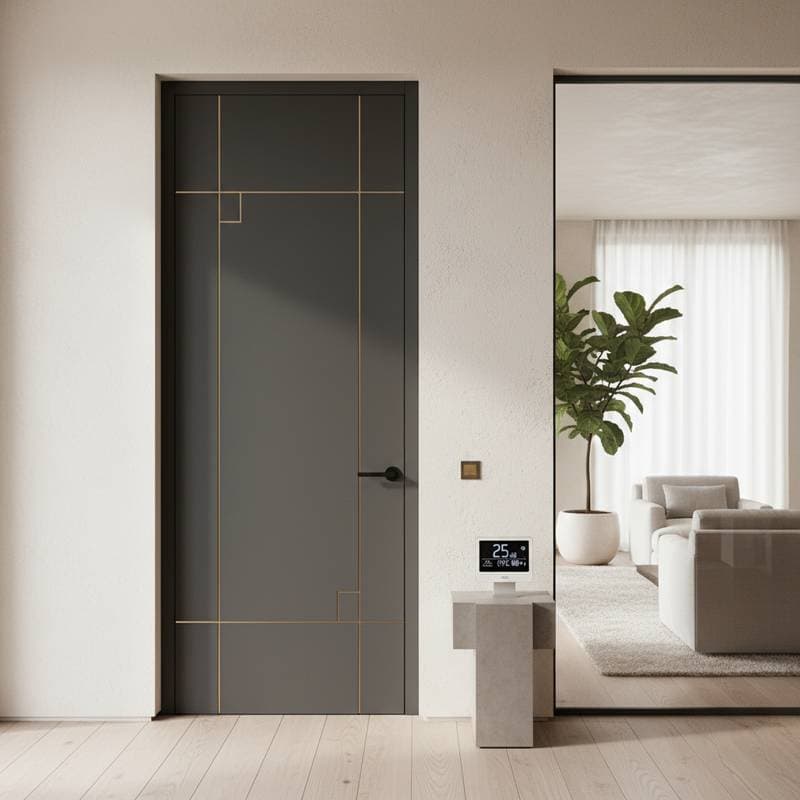Why Homeowners Invest $8,000 in Soundproof Doors
Homeowners increasingly prioritize acoustic privacy alongside traditional home features like layout and decor. Urban density and the rise of remote work have elevated the demand for effective noise reduction, turning soundproof doors into essential upgrades. Many now allocate up to $8,000 per door for installations that deliver substantial quiet and enduring benefits.
Core Benefits of Soundproof Doors
Soundproof doors minimize noise transmission between rooms through strategic design elements. These doors incorporate dense cores, layered materials, and perimeter seals to block and absorb sound waves effectively. Standard doors, typically hollow and lightweight, permit easy passage of disturbances, whereas soundproof models achieve superior isolation.
Performance relies on Sound Transmission Class (STC) ratings, which quantify noise reduction capabilities. Ratings above 40 offer significant improvements for everyday annoyances like conversations or appliances. Homeowners notice enhanced focus in offices, better rest in bedrooms, and immersive experiences in media rooms.
Key Materials and Construction Techniques
Premium soundproof doors employ robust materials to balance acoustics, durability, and style. Solid wood or composite cores add necessary mass to impede sound travel. Acoustic laminates, consisting of multiple thin layers, diffuse vibrations and prevent resonance.
Perimeter seals, often made from rubber or brush materials, eliminate air gaps that allow sound leakage. Frames receive reinforcement to support the door's weight and ensure precise alignment. Custom veneers in various wood species allow seamless integration with existing interiors, though these choices elevate costs.
High-end constructions combine these features for STC ratings in the 45-50 range. Such doors withstand daily use while maintaining performance, justifying the investment through longevity and efficiency.
Performance Comparison Across Door Types
Selecting a soundproof door involves assessing cost, durability, and suitability for specific needs. The following table outlines common options:
| Option | Initial Cost | Lifespan | Maintenance | Best For |
|---|---|---|---|---|
| Hollow-core interior door | $100 to $400 | 10-15 years | Minimal | Standard rooms with low noise |
| Solid-core wood door | $400 to $1,500 | 20-30 years | Occasional refinishing | Moderate sound control |
| Mid-grade acoustic door | $1,500 to $4,000 | 25-40 years | Periodic seal replacement | Offices, bedrooms, small studios |
| Premium soundproof door | $5,000 to $8,000+ | 30-50 years | Professional inspection every few years | Home theaters, recording rooms, urban homes |
Premium doors excel in demanding environments, providing decades of reliable service. Basic models suffice for minor issues, but advanced options address persistent noise sources.
Impact on Daily Life and Well-Being
Persistent noise disrupts sleep, productivity, and relaxation, as research indicates links to elevated stress and reduced cognitive function. Soundproof doors create isolated zones for work or leisure without major renovations. Families with remote professionals or young children benefit from designated quiet areas.
Environmental factors influence door selection. In humid areas, moisture-resistant composites prevent warping. Sealed designs in cooler climates reduce drafts, enhancing insulation and lowering energy costs. These advantages extend beyond acoustics to overall home efficiency.
Step-by-Step Installation Guide
Effective installation maximizes a soundproof door's potential. Professionals begin with site assessment, measuring the opening and inspecting adjacent walls for insulation quality. Recommendations for supplementary treatments, such as wall panels, arise if needed.
Preparation involves removing the existing door and frame, followed by any required adjustments for plumb alignment. The new frame installs first, ensuring secure anchoring to the structure. The door then mounts with heavy-duty hinges, and seals apply around edges.
Final steps include testing for closure and sound integrity, often using basic audio tools. Homeowners receive care instructions, with most projects concluding in one day. Complex setups, like those in older homes, may extend to two days.
Assessing Investment Value
The $8,000 price tag reflects advanced engineering and customization, comparable to premium windows or cabinetry. These doors boost home resale value by appealing to buyers seeking modern comforts. Energy savings and reduced noise complaints further offset initial outlays.
Consider usage frequency, local noise levels, and current construction when deciding. Frequent reliance on the space, such as daily home office hours, amplifies the return. Aesthetic matching ensures the upgrade enhances rather than detracts from design cohesion.
Ongoing Maintenance Practices
Soundproof doors demand straightforward care to sustain effectiveness. Annual checks of seals and hinges prevent minor issues from compromising seals. Clean surfaces with mild solutions, avoiding abrasives that damage finishes.
Adjustable gaskets tighten as needed, and professional servicing every five years addresses wear. Refinishing wood elements refreshes appearance and protects against environmental factors. Consistent attention yields performance comparable to new installations over 30 years.
Tailoring Choices to Your Home
Match door specifications to your household dynamics for optimal results. Mid-grade options handle typical urban sounds, while premium models suit professional audio needs. Consult specifications for STC alignment with your noise challenges.
Budget for professional installation to avoid performance pitfalls. Explore samples to verify finish compatibility. This targeted approach delivers quiet that aligns with lifestyle demands and elevates home functionality.
Realizing Lasting Acoustic Advantages
Investing in a premium soundproof door fosters serene environments that support health and productivity. These upgrades integrate seamlessly, providing privacy and efficiency for years. Homeowners gain not just silence, but spaces optimized for modern living.






